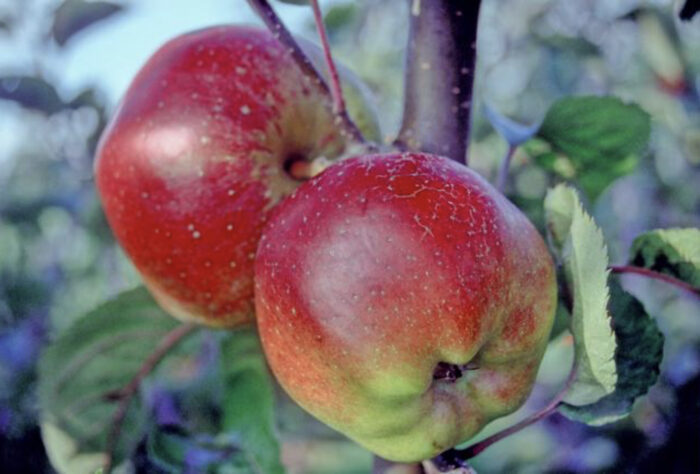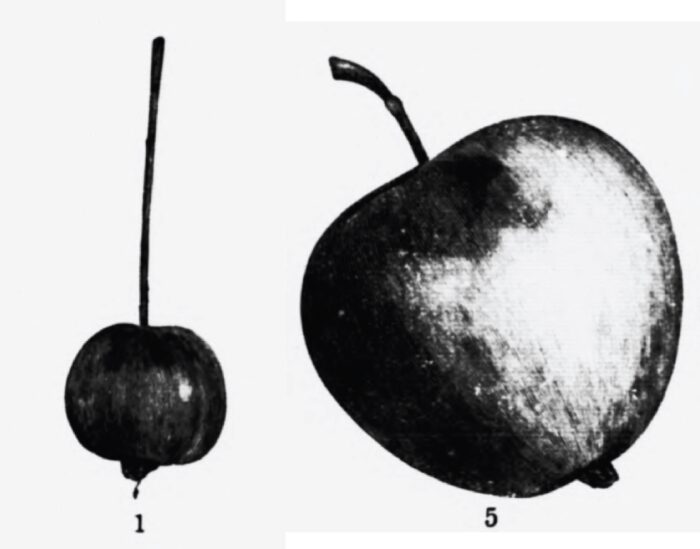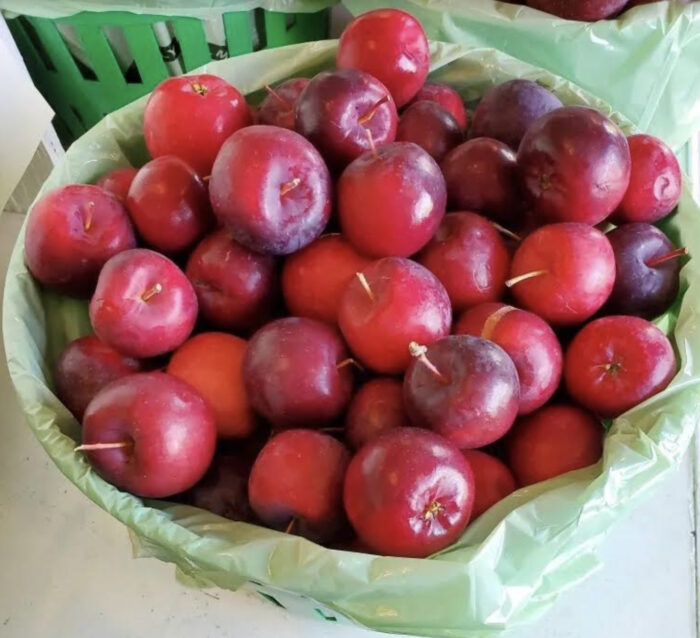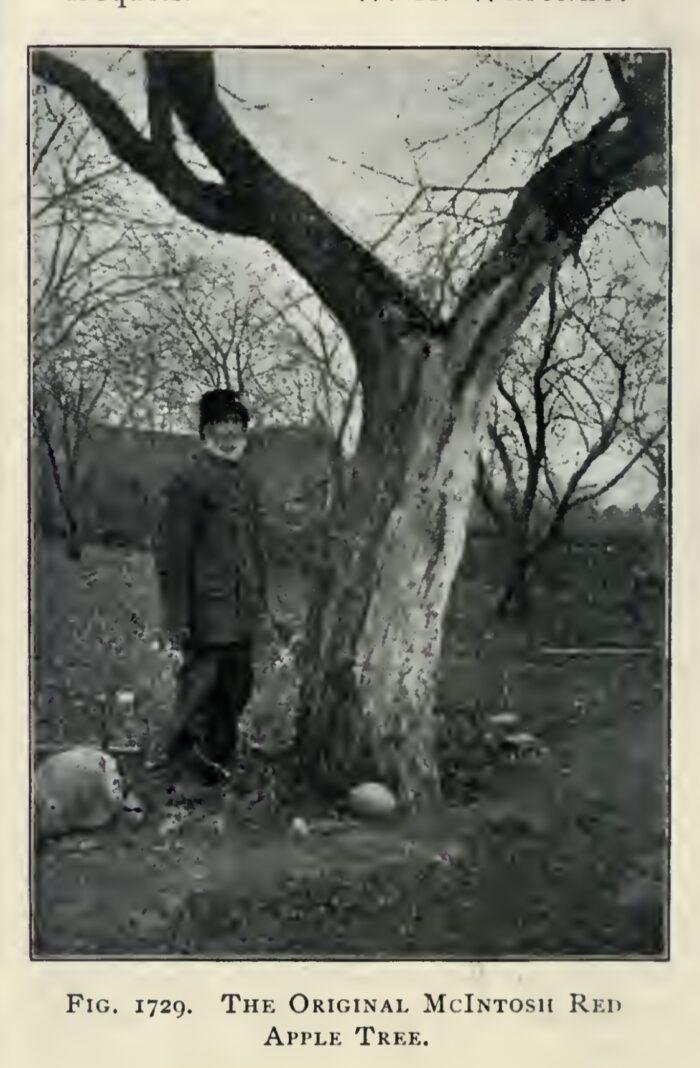
Remeber when Al Gore said he invented the internet?
He didn’t really, but statements he made in a 1999 interview suggested to some that he was claiming he had and taking credit where it wasn’t due. People do sometimes engage in a little puffery to make themselves look more important; perhaps that’s just a part of human nature. It can involve something consequential, like the internet, or something small. It can even be something that seems, to us anyway, as being pretty unimportant, like who discovered a famous apple. Herein lies the story of Baldwin.
Baldwin sprouted sometime in the middle of the 18th century in Massachusetts, though where exactly depends a bit on which origin story you believe. At the time, apple growing in New England looked very different than it would by the mid-19th century. This was a time of subsistence farming; almost everything an individual or family needed had to be produced on the farm. Stores were non-existent, unless you lived in a major city. Communities were isolated and what roads there were rudementary and often unusable. Apple trees were planted from pommace and located along the margins of fields growing grains, potatoes, or grasses that could be harvested for winter fodder. Starting from seed is a crap shoot. It takes years to get any fruit and more often than not what you do get isn’t something you’d put in your kid’s lunch box. That was just fine as most of the apples went into cider or vinegar. An apple that had something noteworthy about it, then–size or flavor or the ability to stay edible for months–stood out. Baldwin was one of those exceptions. It was a decent size, an attractive red color, tasted great, and lasted well into the spring.
Competing stories as to Baldwin’s origin began showing up in the agricultural press in the 1820s. It started with an article in the March 17, 1826 issue of The New England Farmer, a reprint of a piece that had appeared more than ten years earlier1. It was, in part, a complaint about “great inattention which has heretofore been paid to the names of fruit trees,” and tells the imagined story of a farmer that had grafted over his orchard to a new variety called the Pecker apple because he’d heard such good things about it. He waited five years for fruit and was disappointed to discover that it was an apple he already had plenty of, one that he knows as Baldwin. The next week’s issue followed with a letter from a Jos. Harrington offering to explain how the apple came to have two names. Its discoverer, he wrote, was a Col. Baldwin of Woburn who had been out “surveying in the wilderness” and came across a tree that had holes in its trunk from a woodpecker and bore remarkable fruit. He took scions from the tree and “introduced it into better company” calling it the Pecker apple.
Less than a month later, another letter appeared, this time from J.B. Brown, offering a slightly different tale. There was in the town of Wilmington, he said, a man by the name of Butters who discovered a chance seedling tree on part of his farm and moved it to a place nearer his house. Folks in the neighborhood admired the apple and to took to calling it the Butters apple. Butters eventually decided that Woodpecker, or Pecker, would be a more apt name since the birds were so attracted to the tree. Col. Baldwin, Brown wrote, took Butters’ apple and introduced it into the market where it came to be called Baldwin, though people around Wilmington continued to call it Woodpecker since Butters “certainly had a right to christen the spontaneous productions of his own soil.”
The first two stories are not inconsistent; Harrington may not have know that Baldwin’s “wilderness” was actually part of Butter’s farm. But, then in 1835, a new claimant arose. Rufus Kittredge wrote to the editor of The Magazine of Horticulture to announce, with no uncertainty, that the original tree grew on the farm of his grandfather, John Ball, on land bought in 1740 somewhere between Lowell and Tewksbury, both of which are well north and west of Wilmington, though all are in Middlesex County. Kittredge’s father said he remembered seeing the tree as a child and was sure it wasn’t a graft because nobody in Tewksbury knew how to graft trees then. Once again, Col. Baldwin is credited with noticing and popularizing the apple.
The third claimant appeared sometime later in a piece written about Baldwin in the Green Mountain Freeman (Montpelier, VT)2. In this account the first tree grew in the orchard of Samuel Thompson of Woburn (southeast of Wilmington but pretty close) about the time of the revolution and, again, called the Woodpecker. Boys use to steal the apples, which is apparently how it came to the attention of, once again, Col. Baldwin. Taking scions and grafting trees of his own, Baldwin then insisted it should bear his name, according to this version of the tale. “Now we submit whether. . . the fruit in question be called the Thompson Apple, “ wrote the author, “provided nevertheless, that the new christening does not conflict with any previous right of the Woodpeckers?” (It may be worth knowing that the editor of the Green Mountain Freeman, and the possible author of the article, was a distant relation of Samuel Thompson.)
From the 1820s well into the 20th century, these several stories circulated. Horticultural authors would pick one or another to include, or ignore them all and just mention that Baldwin originated in Massachusetts. More letters were written and embellishments and changes appeared. John Ball was said to have sold his farm to Butters in 1740, instead of that being the year he bought it. Samuel Thompson was cast as the surveyor that discovered the tree in the wilderness. Col. Baldwin was said to have discovered it as a young student walking back home from Cambridge with his friend. He was also described as being so enthusiastic about the apple later in life that he would take scions with him everywhere he went, handing them out freely to anyone who’d take them. Competing and inconsistent stories would even appear in the same book3. More often than not, someone involved in the retelling of the story was related in some way to the purported discoverer. Why did they care so much?
The early 19th century was a turning point for American agriculture, especially in New England. New canals were connecting isolated navigable waterways, meaning that farmers in rural areas had a reasonable way to gain access to urban markets. That’s what Baldwin, or Thompson, was up to in Middlesex County in the late 1790s, conducting land surveys to determine the best route for a canal through the area. People were fired up with the possibilities of their new country and, at this point, agriculture was the key. Societies for promoting “better” “more scientific” farming practices were formed. (Col. Baldwin was a founder of the Massachusetts Agricultural Society, along with President-to-be John Adams.) An agriculture-centered press was thriving, acting as both a conduit for information about the latest techniques and varieties and a forum for widespread debate about the same subjects.
Among the “improvements” promoted by the scientific agriculturalists was the planting of fruit trees in orderly rows in orchards instead of along a field’s margins and, more consequentially, abandoning the reliance on whatever apples happened to grow from seed in favor of grafting them over to established, marketable apples, especially those varieties that kept well. This was the time when the names of apples became truly important. They were how a farmer knew he was growing something with known qualities that he could sell, and the consumer could be assured that she was buying something good.
Baldwin fit perfectly into the new way of thinking and was recommended constantly in the press, along with Newtown Pippin and Roxbury Russet. Farmers grafted them by the hundreds. They blanketed Massachusetts, spread to all corners of New England, then on to New York. Baldwin traveled west, first to Ohio, then on to the rest of the country as America expanded. It was famous. Who wouldn’t want to have descended from someone that had discovered one of the most important agricultural commodities in the country?
Each of these origin stories seems to hold at least a kernel of truth, but the details don’t always fit. For example, there are no records that would suggest anyone by the name of Ball owned land near Wilmington, though the Butters family had been there since the town was founded in the mid-1600s. (A helpful descendant, when writing a family history in 1896, included a detailed story and a map showing where family lore indicated the tree had been planted.) The earliest record of the apple is, in fact, a 1799 letter sent by Col Baldwin to his friend Benjamin Thompson in England. “In the cask of fruit which your daughter and Mr. Rolfe have sent you, there is a half a dozen apples of the growth of my farm, wrapped up in papers with the name of Baldwin apples written on them [emphasis in the original],” he wrote. “[I]t would gratify me much to know the true English name of it. However, I rather doubt whether the nice characters of this apple will answer exactly to any particular species of English fruit, as it is (I believe) a spontaneous production of this country, that is, it was not originally engrafted fruit.”4 It’s rather a shame he didn’t share the source of his scionwood.
Each of these origin stories seems to hold at least a kernel of truth, but the details don’t always fit. No one alive at the time thought to leave a diary or letter that mentioned finding an amazing apple, so we are left to choose whichever story we think is the most likely. Still, whatever one wants to believe about who discovered Baldwin and when, it’s been in continuous commercial production for nearly 200 years and is one of the most important apples in the northeast. A number of cidermakers are working with it with some flavorful results. The dominant feature in the ciders I tried was yellow fruits, plus a zingy acid and not much in the way of tannin, though all had a mildly bitter, though not unpleasant, finish. The sample size was small since Baldwin seems to appear in blends more than as a single variety. I’ll be on the lookout for more, though.
Kite & String/Finger Lakes Cider House, Interlaken, NY – dry; lemon, lime, just ripe pear skin, yellow plum skin, yellow apple, slight creaminess, mild bitterness on the finish; sparkling; undated; 8.4% ABV
South Hill Cider, Ithaca, NY – dry; vanilla, ripe yellow apple, lemon and orange rind, pear skin, toast, quince, mild bitterness on the finish; sparkling; 2018; 8.5% ABV
Angry Orchard Innovation House, Walden – dry; lemon, yellow plum skin, pear skin, yellow apple, mild bitterness on the finish; sparkling; bottled 2016; 7.9% ABV
1. In the Massachusetts Agricultural Repository and Journal (v3, 1815)
2. Reprinted in the North Star (Danville, VT, March 9, 1850)
3. Cutter, William Richard, Historic Homes and Places and Genealogical and Personal Memoirs Relating tot he Families of Middlesex County, Massachusetts, 1908
4. Ellis, George E., Memoir of Sir Benjamin Thompson, Count Rumford, 1876, Estes and Lauariat, Boston





